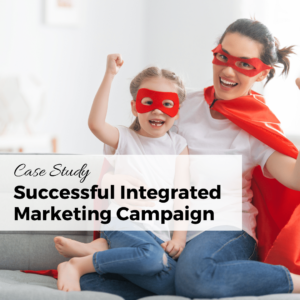The Power of Holistic Marketing
For your business, success is often determined by the strength of your marketing strategy. But what if there was a way to amplify your marketing efforts, creating a cohesive, integrated approach that drives results? Enter holistic marketing, a strategy that combines all aspects of marketing communication such as advertising, sales promotion, public relations, and direct marketing, working together as a unified force, rather than permitting each to work in isolation.
Integrated marketing was actually one of the courses towards my degree, which taught me that having cohesive marketing strategies is the best way to make sure that the sum of the whole is greater than the individual parts.
I’m going to share a real-life case study of a business that saw remarkable results through a holistic marketing approach. We’ll walk you through their journey, highlighting the key strategies and tactics that led to their success. This will help spur some ideas for your own marketing strategies.
And remember, while we’re here to guide you, the real hero of this story is the business itself. They took the leap, embraced a new approach, and reaped the rewards.
Don’t forget … the whole point of your business becoming a hero is so that you can have a better life!
The Before: A Business in Need of Direction
Our story begins with a small business, let’s call them Company X. They had a dedicated team, a solid product, and a clear vision. And these are important aspects – your people and your product are two of the 5 Ps of Marketing … and your clear vision is articulated through your brand messaging.
However, they were struggling to make their mark in a crowded market. What we found is that their marketing efforts were disjointed, with different team members pursuing separate strategies. Sometimes the strategies actually overlapped and we realized that they were often paying two different contractors to do the same job, yet each was doing it differently, resulting in watering down of their brand message.
Over the years they had also added new strategies, often learned as part of a paid program or course, and each of these required their own systems and software platforms (this is one of my biggest pet peeves … marketers who only know one way to do things, which results in you having to conform to their methods, rather than their methods enhancing the things that your business already does well. I’ll step down off my soapbox now!). This meant that they were paying for multiple systems that did the same thing, and instead of streamlining their work, none of the systems worked together, so they were actually manually duplicating the work to get everything added to all of the different systems. Technology is supposed to make your life easier, and in their case it was only making things harder.
They were spending time and money, but not seeing the return they desired.
So my team came in with unique approach to marketing that’s proven to drive conversions. With a deep understanding of the importance of getting branding and voice right quickly, we were able to help Company X put the right things first, setting them up for future growth. The systems and strategies work now, and are also put into place to work as the company grows, without having to start over with something new.
The Strategy: Embracing Holistic Marketing
We Company X to the concept of holistic marketing. This approach focuses on creating a unified, integrated marketing strategy that takes into account all aspects of a business. It’s about ensuring that everything from your branding to your social media presence to your customer service is aligned with your overall business goals – revenue goals and even the bigger goals such as the legacy that you want to leave.
The first step was to conduct a thorough audit of Company X’s existing marketing efforts. While understanding the end goals is important, you can’t realistically understand the things that you need to get there unless you know where you’re starting. If you invited me to a dinner party at your house and gave me the address, even my GPS needs to know where I’m starting so that it can make a roadmap to get there.
This audit revealed areas of strength, as well as opportunities for improvement – such as streamlining the workload. From there, we developed a comprehensive marketing plan, tailored to Company X’s unique needs and goals. It wasn’t exactly like the one we had crafted the week before for Company W, because their businesses aren’t the same and their marketing plan shouldn’t be, either.
The Implementation: A Unified Approach
With a clear plan in place, it was time for implementation.
We worked closely with Company X to ensure that every aspect of their marketing was aligned with the new, holistic strategy. This included everything from revamping their website for better SEO and to more closely align with their finetuned brand messaging, to developing a consistent brand voice, to implementing effective social media strategies.
One key aspect of this implementation was stopping the things that weren’t as effective. The plan isn’t that they can never be used again, but it’s to focus heavily on those areas that were already receiving the biggest results. We then layered in some strategies that the business had never even considered, but that we knew from experience could see great results in their industry.
One of the favorite additions of us – and them? Fun user-generated content strategies, that were able to get their audience more directly involved in their company.
The Results: Success Through Integration
The results of this holistic marketing approach were impressive.
Company X saw a significant increase in website traffic, social media engagement, and most importantly, conversions of visitors into paying customers. They were able to reach their target audience more effectively, and their audience was responding.
- Website traffic increase: 717%
- Increase in website conversions: 527%
- Increase in repeat customers: 285%
- Decreased customer acquisition cost: -72%
- Increase in customer LTV: 357%
But the benefits didn’t stop there. By taking a holistic approach, Company X was able to create a stronger, more cohesive brand image across all of their online – and offline – platforms. Their audience began to recognize and trust their brand, leading to increased customer loyalty and repeat business.
Tracking the Results of a Holistic Marketing Strategy
One of the challenges of implementing a holistic marketing strategy is tracking its results. Unlike more traditional, siloed approaches, the success of a holistic strategy isn’t just the sum of its parts. It’s about how all those parts work together to create a greater impact.
While traditional metrics like website traffic and social media engagement are still important, they don’t fully capture the value of a holistic approach. To truly understand the impact of your holistic marketing strategy, you need to look at the bigger picture.
The Importance of Comprehensive Tracking
Comprehensive tracking is crucial for understanding the full impact of your holistic marketing strategy. This involves looking beyond individual metrics and considering how your marketing efforts are working together to drive results.
For example, you might notice that your website traffic has increased since implementing your holistic strategy. That’s a great start, but it doesn’t tell the whole story. You also need to consider factors like the quality of that traffic, the behavior of those visitors once they’re on your site, and whether they’re ultimately converting into customers.
Key Metrics to Consider
When tracking the results of your holistic marketing strategy, consider the following key metrics:
- Customer Lifetime Value (CLV): This is the total revenue you can expect from a single customer over the lifetime of their relationship with your business. A successful holistic marketing strategy should increase your CLV, as it not only attracts new customers but also fosters loyalty and repeat business.
- Customer Acquisition Cost (CAC): This is the total cost of acquiring a new customer, including all marketing and sales expenses. A holistic approach can often reduce your CAC, as it leverages multiple channels and strategies to attract customers more efficiently.
- Brand Awareness: This is the extent to which potential customers recognize and are familiar with your brand. While harder to quantify, increased brand awareness is a clear sign that your holistic marketing strategy is working.
- Customer Satisfaction: Happy customers are more likely to become repeat customers and refer others to your business. Consider conducting regular customer satisfaction surveys to gauge the impact of your holistic marketing efforts.
Using the Right Tools
There are many tools available that can help you track these and other metrics. Google Analytics is a powerful tool for tracking website traffic and user behavior, while CRM software can help you track CLV and CAC. Social media platforms also provide analytics tools to measure engagement and reach.
Which tools you need to use will depend upon which metrics you need to track.
Remember, the goal of tracking is not just to validate your marketing efforts, but to gain insights that can help you refine and improve your strategy over time. By tracking the right metrics and using the right tools, you can ensure that your holistic marketing strategy is delivering the best possible results for your business.
The Takeaway: Your Business Can Achieve This Too
The success of Company X is not an isolated case. With the right guidance and a commitment to a holistic marketing approach, any business can achieve improved results.
At Vicky Wu Marketing, we’ve helped tens of thousands of entrepreneurs over the past 25 years, clearing away the clutter and focusing on marketing strategies that are proven to work.
FAQs on Holistic Marketing
- What is holistic marketing? Holistic marketing is a strategy that combines all aspects of marketing communication such as advertising, sales promotion, public relations, and direct marketing, working together as a unified force, rather than permitting each to work in isolation.
- How does holistic marketing benefit a business? Holistic marketing creates a unified and integrated marketing strategy that aligns all aspects of a business. This can lead to increased brand recognition, improved customer loyalty, and ultimately, higher conversions.
- What does a holistic marketing strategy look like? A holistic marketing strategy includes a comprehensive audit of existing marketing efforts, development of a tailored marketing plan, and implementation of this plan across all aspects of the business.
- How does SEO fit into a holistic marketing strategy? SEO is a crucial part of a holistic marketing strategy. It helps improve a business’s online visibility, making it easier for potential customers to find them. This includes optimizing website content, using SEO-friendly anchor text, and implementing effective social media strategies.
- Can my business benefit from holistic marketing? Absolutely! No matter the size or industry of your business, a holistic marketing approach can help you reach your target audience more effectively and drive conversions.
Remember, the key to successful marketing is a holistic approach that puts your business at the center of the strategy. With the right guidance and a commitment to integration, your business can achieve the same success as Company X.
Schedule a Free Marketing Consultation
to Brainstorm Possibilities for Your Business

Vicky is the CEO and Chief Creative Strategist of Vicky Wu Marketing. She draws from 30 years of experience at the CMO level, the CEO level, marketing for Fortune 500 companies and multi-million and multi-billion-dollar organizations, PLUS strategies learned helping startups and nonprofits with limited budgets … now focusing on providing SMBs with effective and efficient marketing strategies – giving them access to the same level of expertise as the really big guys with deep pockets, that they may not otherwise be able to access.








